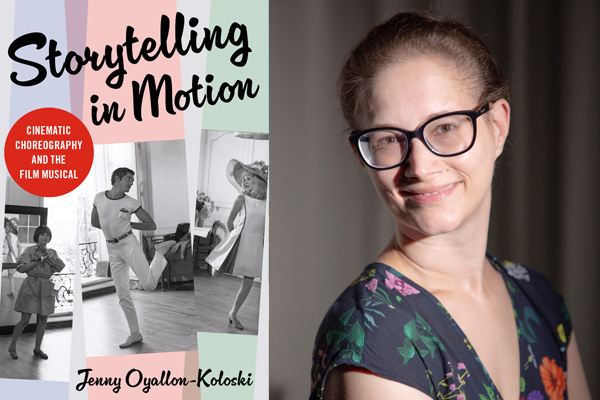Jenny Oyallon-Koloski considers the power of movement in film in her first book: ‘Storytelling in Motion’

Three vertical mirrors hang on the wall in the office of Jenny Oyallon-Koloski, assistant professor of media and cinema studies, where she keeps an open area that allows her the space to move.

Michael J. Junokas performing at the McLean
County Arts Center in Bloomington, Illinois.
As a certified movement analyst and director of the movement visualization (mv) lab, she wants the space to serve as a research environment where she can use motion-capturing technology to study the manifestations of human movement in cinematic space.
Her extensive research on how figure movement and dance create meaning in musical cinema is the subject of her first book, Storytelling in Motion: Cinematic Choreography and the Film Musical (Oxford University Press), which will be available May 17.
Oyallon-Koloski’s idea for the book came out of her dissertation project, which tied her interest in dance and movement into her core work in film and film history.
While her dissertation focused mainly on French filmmaker Jacques Demy, using his films as case studies, her book discusses broader ideas of how people can understand the significance of dance in film.
“That’s one of the core questions [in the book]—how do filmmakers use movement to tell stories, and specifically in the musical genre,” she said.
Her book also compares French and American film production histories and considers the impact of time, money, and rehearsal space available to filmmakers.
“What I found was really interesting between French and American musicals is Hollywood had a symbiotic relationship with Broadway, and those industries or artistic sectors kind of grew together. So there was all this culture around dance and musicals, at least in the Hollywood system. But in France, those artistic sectors were really separate,” she said.

Oyallon-Koloski discovered an interest in dance and movement in college. While doing her dissertation research, she became a certified movement analyst at the Laban/Bartenieff Institute of Movement Studies in New York, an educational and research center that trains people in the language of movement.
“I was taking dance classes, but I wasn't getting a specific degree in dance and I really wanted to be able to have credibility with the dance community,” she said.
Oyallon-Koloski spent two years studying the Laban system—a method and language describing, visualizing, interpreting, and documenting human movement invented by Rudolf von Laban in the 1920s—alongside a wide range of students with interests in dance, therapy, academic research, and more.
Using never-before-published interviews with filmmakers and choreographers, she applies the principles from the Laban/Bartenieff Movement Studies to analyze the impact of figure movement in cinema.
Oyallon-Koloski also created three video essays to accompany her written chapters: Seeing Movement in Cinema: An Introduction to Laban Movement Analysis; Endless Conversations: Reflexive Musical Clusters; and Diegetic Flutters: Views from the bridge, which was accepted to the international Marienbad Film Festival to be held in the Czech Republic this June.
Making video essays is one of Oyallon-Koloski’s course specialties, as well as digital media production, contemporary movies, and cinema theory.
Although she doesn’t consider videographic criticism a substitute for writing, Oyallon-Koloski does believe audiovisual context is a way to help generate interest in films, particularly those people have rarely seen.
Oyallon-Koloski, a dual American-French citizen who speaks fluent French and lived in France her senior year of high school, says her familiarity with the culture enabled her to write a book about dance in French cinema, which some might consider a fringe topic.
After completing Storytelling in Motion, Oyallon-Koloski says she realized she still has more to say on the subject of French cinema.
“I think my next project will probably be about [Jacques] Demy and his filmography. He made about 13 films, so [the book would be] less focused on dance and movement and more film history and style,” she said. “I like working with archival collections … and I like the interplay between French cinema and international cinema.”
—Kelly Youngblood
